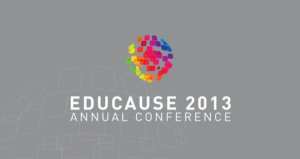 The Radical Transcript
The Radical Transcript
For its Spring graduating class, Elon University of North Carolina is launching a radically different student transcript—the Visual Experiential Transcript or Visual EXP. It’s a significant departure from the traditional. This document aims to provide a holistic snapshot of a student’s undergraduate learning, on and off campus extracurricular activities and leadership experience. All are encapsulated into five domains: internships, research, leadership, service and global education (page 2), in addition to a student’s course work (page 1). So what’s so radical? Student grades aren’t the focus, nor are credit hours.
Elon University’s Two-Page, Visual EXP Transcript

Screenshots (above and below) Elon University’s ‘Visual Experiential Transcript’ launched to its graduating Class of 2016. Transcript development initiative funded by the Lumina Foundation.
 Elon University’s revision to the traditional transcript is an exercise other higher education institutions may want to consider in the near future. Institutions need to show value of the undergraduate experience; value over and above courses completed and grades earned. This new transcript aligns with what many scholars are calling for in higher education—innovation and transformation. This was the message at the recent ‘International Seminar on Innovation in Higher Education’ held last month. Panelists discussed how higher education institutions need to transform and innovate their traditional practices. One example of transformation is demonstrating the value of an undergraduate education; value not only in terms of value to employers, but the contributions undergraduates can make to their field and to society.
Elon University’s revision to the traditional transcript is an exercise other higher education institutions may want to consider in the near future. Institutions need to show value of the undergraduate experience; value over and above courses completed and grades earned. This new transcript aligns with what many scholars are calling for in higher education—innovation and transformation. This was the message at the recent ‘International Seminar on Innovation in Higher Education’ held last month. Panelists discussed how higher education institutions need to transform and innovate their traditional practices. One example of transformation is demonstrating the value of an undergraduate education; value not only in terms of value to employers, but the contributions undergraduates can make to their field and to society.
Talking about the fact that it’s not that we are preparing students for a career, but we are adding value to their lives, we are adding to society, we are adding to the corporate sector. We need the metrics at hand, showing the real contribution of higher education to society — International Seminar on Innovation in Higher Education (2016)
Elon’s transcript is an excellent example of transforming traditional practices in academe. Conventional transcripts need an overhaul given the narrow emphasis—grades and credit hours. Stanford University’s registrar went on record last year stating the transcript is “a record of everything the student has forgotten” (Mangan, 2015). Another reason for a revamp is to highlight students’ value to potential employers. Employers want to know more than a student’s GPA. They are increasingly interested in what a student can do, what knowledge and skills a student developed while working through his or her undergraduate education (Davidson, 2016). It’s time for a transcript overhaul and Elon University is a good example of how an institution aligned its transcripts with their core values. Other schools can do the same.
Further Reading:
- Elon Experiences Transcript, Elon University
- Innovation in higher education is about anticipation, (2016), University Worlds News
- Changing Records of Learning through Innovations in Pedagogy and Technology, (2016) EDUCAUSE Review
- A Framework for Extending the Transcript (Draft June 2015), The American Association of Collegiate Registrars and Admissions Officers and NASPA
NEW: Personalized Learning on LinkedIn
Personalized and lifelong learning is an expanding market as evidenced by the rise of MOOCs, offerings of nano degrees, micro masters, and alternative credentials. LinkedIn is getting in the game with a new platform Learning Lab, launched last week. Last year LinkedIn purchased Lynda.com for $1.5 billion (Kosoff, 2015); it’s now the foundation for LinkedIn’s new platform. It consists of a suite of learning videos on a variety of topics, from web development, to digital marketing to leadership. But LinkedIn Learning is adding another layer to the 9000+ videos. It’s developing algorithms with the data they’ve acquired from the millions of LinkedIn members to personalize learning for premium subscribers.
LinkedIn Learning creates personalized recommendations, so learners can efficiently discover which courses are most relevant to their goals or job function. Organizations can use LinkedIn insights to customize multi-course Learning Paths to meet their specific needs. We also provide robust analytics and reporting to help you measure learning effectiveness. – LinkedIn, The Learning Blog (2016)
LinkedIn plans to expand its focus beyond individual subscribers and reach the corporate sector. Businesses will be able to buy subscriptions for employees and customize ‘Learning Paths’—multi course bundle courses targeting a specific skill set. Human resource managers will be able to use LinkedIn’s analytics tools to monitor employees progress, recommend learning paths, as well as look at which courses their employees are engaging with.
With Learning Lab, LinkedIn is going beyond it’s role as a professional networking site to a skill and career development platform. Sound familiar? Coursera recently launched ‘Coursera for Business‘ , as did Udacity, with Udacity for Business and edX with Professional Certificates. MOOC providers are already tapping into the employee development market with skill specific, just-in-time learning that is available anytime, anywhere. This type of skill development—personalized learning that is accessible and inexpensive is essential for developing skills and preparing a workforce for economies moving towards automation and sectors that are focused on technology and energy. LinkedIn’s new Learning platform might be part of the solution to meet the challenges of delivering just-in-time learning for focused skill development to meet the needs of a new workforce.
Further Reading:
- Linked In doubles down on education with Linked In Learning, (2016), TechCrunch
- Introducing LinkedIn Learning, a Better Way to Develop Skills and Talent, (2016) Linked In Learning Blog
- On-demand learning for your company, LinkedIn
Image credit: Light bulb, by geralt on Pixabay






